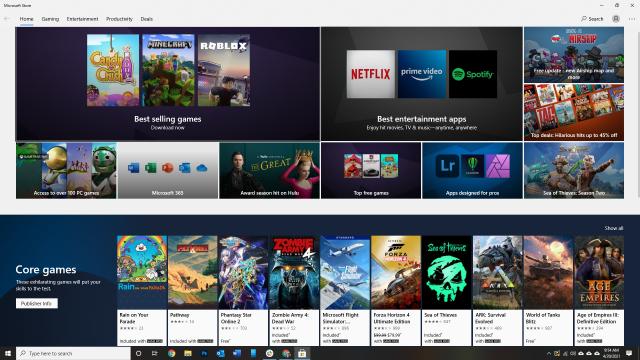Microsoft is reportedly reworking its entire Store app in Windows 10, including policy changes for developers and making the UI easier to navigate. Windows Central reports the changes are a sweeping rejuvenation of the Microsoft Store, changes that will hopefully encourage Windows 10 users to use the app more often and encourage more developers to make their apps and games available through the store.
The rumour is sort of unsurprising, considering Microsoft is chugging right along with its codenamed “Sun Valley” initiative, or its major UI code overhaul expected to debut with Windows 10 21H2 sometime in during the second half of this year. Microsoft has already made a number of changes for its Windows Insider users, like new Documents, Music, and Video folder icons, but it has yet to comment publicly on Sun Valley.
The Microsoft Store was first introduced with Windows 8 as a way to “link” apps across PCs and Windows phones, tablets, and Xbox consoles. It was a very “Apple ecosystem” approach, but given how poorly Windows 8 and the Windows phone were received, the initiative fell apart and the Microsoft Store was neglected.
In its current state, the app is clunky, slow, and unintuitive. Many of the featured games are also available on the Xbox app, Steam, or elsewhere. The same goes for desktop apps, movies, and other programs like Microsoft Office. Everything can be downloaded directly from another source that is, by comparison, better designed, so there isn’t much incentive for a lot of Windows 10 users to use the Microsoft Store at the moment.
There are tons of apps available through Windows Package Manager, including many that are missing from the Microsoft Store. Windows Package Manager isn’t necessarily for your average Windows 10 user, since it involves installing apps from a command prompt, but it’s not hard to use either. It’s not too different than typing a search term into your browser to find the download page for a certain program.
Other than redesigning the UI, the policy changes that Microsoft is reportedly implementing will open up the submission process to a greater number of developers. This in turn could open up the Microsoft Store to finally include apps like internet browsers, Adobe Creative Suite software, or other third-party paid or free apps. Currently, developers have to package their apps in a specific file format and use Microsoft’s update mechanisms and commerce platforms. But it’s possible that developers will be able to use different file formats and manage their own content through their own delivery network rather than only through Microsoft’s.
If that’s the case, then Microsoft won’t be able to take a cut from developers who elect to use their own in-app purchase systems. (Unlike Apple, which locks developers into putting their apps on its App Store if they want their program on iOS.)
These alleged changes to the Microsoft store seem like they could be a positive thing, but we’ll believe it when we see it.
